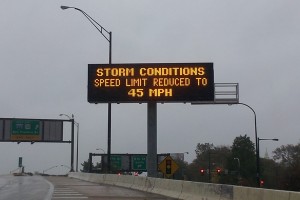NPR: Protecting fuel supplies post-Sandy
-
Katie Colaneri

The entrance to the Benjamin Franklin Bridge in Philadelphia. During Hurricane Sandy, the Delaware River Port Authority banned truck traffic from the city’s bridges due to high winds.
Correction: An earlier version of this story reported that Philadelphia Energy Solutions was shut down during Hurricane Sandy. The refinery remained open, but did shut down some units. Other units remained in “standby” mode.
One year ago today, Hurricane Sandy made landfall on the eastern seaboard. The storm knocked out power for more than one million Pennsylvanians and shut down refineries across the region. Gasoline shortages caused long lines and frustration at the pumps in New Jersey and New York.
Philadelphia Energy Solutions, the former Sunoco refinery in South Philadelphia, did not suffer any damage from the storm and continued running, but at reduced operations during the worst of the storm.
The impact on the petroleum industry was felt long after the storm had passed. GasBuddy.com reported last November that refineries were operating on reduced output of less than 60 percent of their total capacity. Philadelphia Energy Solutions supplied roughly 50 percent of all the fuel in the region for the weeks after the storm.
Our friends at NPR took look at look at how the industry and policymakers have been examining the problem:
The fuel-supply problems went well beyond gas stations though. The storm surge from Sandy damaged local supply terminals, those big, round tanks that are often found near water. [Tom Kloza, chief oil analyst with GasBuddy.com] says these can’t be moved to higher ground.
“You’re going to have problems because the very nature of the storage business is that it has to be very close to shipping lanes and ship channels and that puts it close to sea level,” Kloza explains.
While many of these facilities have been there for decades, climate change could mean that a facility that was once above flood level now is not. Making those facilities more resilient will require significant work.
“It could be looking at berms, looking at elevating cables, looking at elevating motors — other equipment that traditionally has been at ground level, we need to raise that above that flood plain level to ensure that salt water doesn’t impact that infrastructure,” says Patricia A. Hoffman, assistant secretary for the Office of Electricity Delivery and Energy Reliability at the U.S. Department of Energy.
















